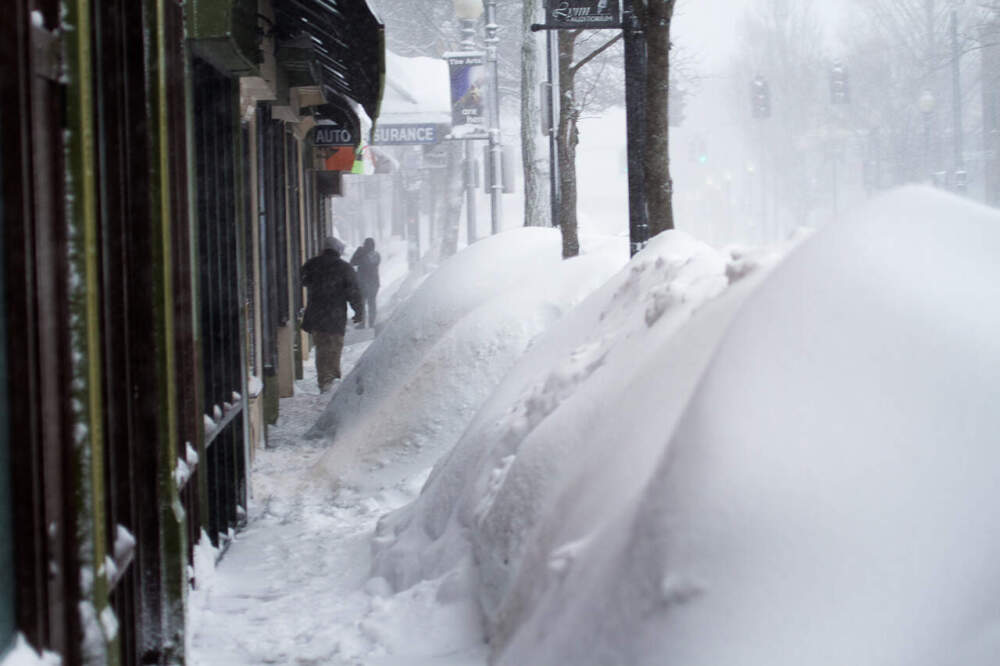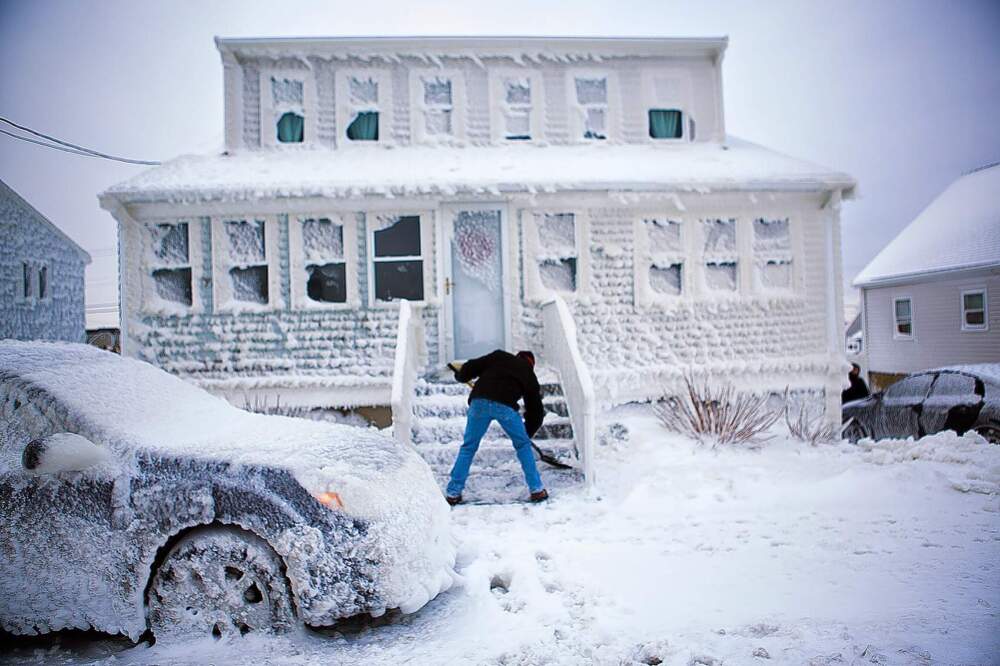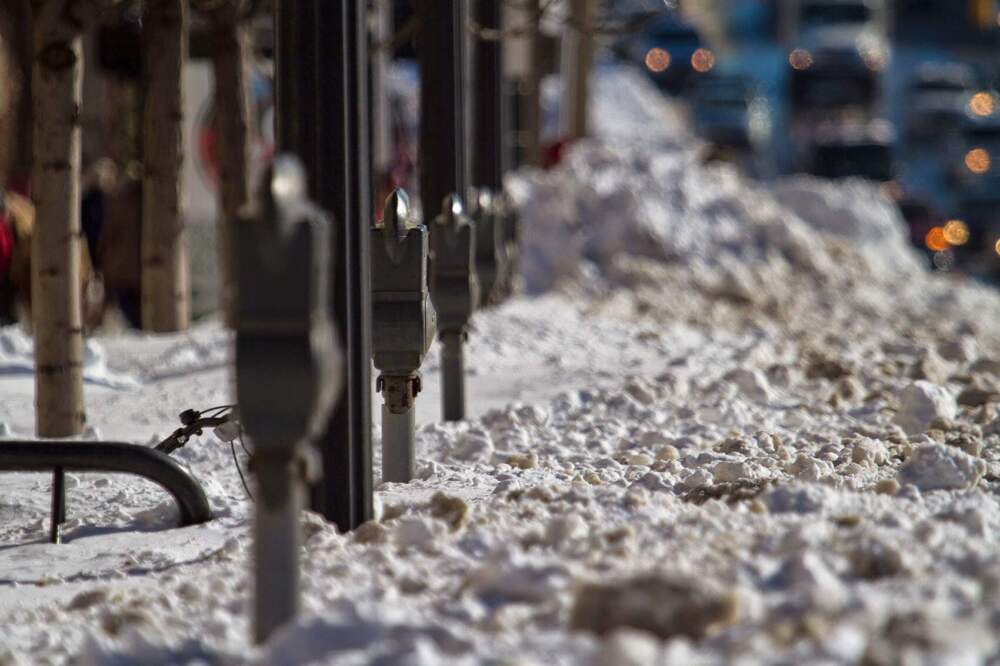Advertisement
Commentary
We're in our 'global weirding' era

When Bostonians talk about snowmageddon 2015, they are probably referring to the bear of a snowstorm named Juno, which dumped 24.6 inches on Boston at the tail end of a meek January, becoming the sixth-largest in the city’s history. But in retrospect, Juno was the easiest part of that whole snowpocalyptic month or so that defined the winter of 2015.
When Juno passed, my husband and I jumped into action. I shoveled the steps and whisked snow off the porch of our Dorchester home with a plastic broom, while he ran our cheerful green electric snowblower around the driveway and sidewalks, spraying crystalline fountains in the morning sunlight.
Then nearly 17 more inches fell a few days later (at the beginning of February), and another 14 inches a week later. It was too cold for the snow to melt between storms; it just slouched onto its haunches, getting denser and icier. Still, during those first storms, there was an agitated pleasure to cocooned life. We were both working from home, so we tapped keyboards in sweatshirts and pajama pants all day and huddled with the cat at night, listening to the vinyl windows of our old house gasp and quake. It was a lifestyle that, in retrospect, prefigured life during the COVID-19 shutdown five years later.

But eventually, the stolen pleasure of snow days wore off. Another big storm came over Valentine’s Day weekend, breaking the monthly snow record from the notorious Blizzard of '78. And then came a deep freeze. Ice dams loomed at the edge of roofs all over the neighborhood. I whacked thick icicles from our eaves with my broom handle. We bought a snow rake, a device I never knew existed, to prevent damage to our roof. I developed new shoveling techniques to fling snow higher, until I could no longer clear the top of the piles in our yard. The snowblower shorted out. Sick of home, I found a deal on a hotel downtown just so we could escape for a night and cook ourselves in a hot tub.
Around us, sidewalks became icy canyons; most people simply walked in the street. Snow piles grew so high that drivers couldn’t see around them. People were killed by snowplows. On March 15, three more inches of snow (a dusting!) edged the city over its all-time seasonal snowfall record at 108.6 inches. The event was grimly celebratory — Bostonians like nothing more than to be superlative. The black remnants of that winter’s snow piles in South Bay didn’t melt until June.
We’ve had some snows since then, but nothing like that winter. Looking back on the past few anemic winters, it’s easy to see 2015 as a final hurrah of winters now weakened by warming temperatures. But that’s not the whole truth. Back then, we learned from climate experts that these record-breaking snowstorms were themselves a sign of climate change. Warmer oceans off the coast breathe more moisture into the skies, which coalesces into heavier precipitation. More heat equals more supercharged storms.
Advertisement
That made Juno and the rest of the storms that season a much different story than, say, the Blizzard of ’78, which blew into town and left behind tales of peril, survival and endurance against a freak occurrence of nature. Now, extreme weather is not so much a story as a subtext.

Climate change can be confusing. The 2015 storms gave fodder to climate journalists reporting on the storms as evidence of climate change as well as climate change skeptics who pointed to the storms as a sign that “global warming” was overblown. I hear the latter argument in casual conversations every time we get a good snow or a cold snap. Yes, we’ll continue to have big snows. They will break records. But what we’re losing is predictability. That’s why climate scientist Katherine Hayhoe has coined the term “global weirding” to capture what climate change does to the world.
According to data stretching back to the 19th century from the top of Great Blue Hill, 10-ish miles south of Boston, the city and surrounding area are seeing a steady rise in temperatures and increasing precipitation. Snowfall is more complicated — it rises and falls over decades and has even trended slightly upward. But falling snow doesn’t necessarily stick around in a warmer climate. The Greater Boston Research Advisory Group projects that Boston is likely to see more intense winter storms, but less snow in the future given our warming temperatures.
Long-term trendlines in weather are subtle compared to the vast upward and downward swings we experience each year. In other words, we’re living in a gradual trend that is overshadowed by all the variability we experience in our day-to-day lives. But I’ve spent enough years in Boston to observe the trendline for myself. Long before 2015, I had many memories of shuffling single-file along sidewalk paths carved through thigh-high snow, awkwardly negotiating space with people headed the other way. I have old photos of snowdrifts in the street that only revealed the parked cars beneath because the side mirrors peeked through. I remember when parking space savers were a major subject of policy debate.

Boston winters were reliably awful. Winter was our love-to-hate-it season, a favorite subject of New England griping. Yes, we still get nor’easters, and I keep a snow shovel and a bucket of salt handy during the cold months. But some of the hallmarks of Boston winters are slipping away, and it’s disorienting. During our latest cold snap this January, I pulled out a down coat that had been hanging in a closet for five years. I have wool sweaters that have been more useful to moths than to me lately. Reading my daughter children’s books about snowy days and sled rides has started to feel as outdated as depictions of corded telephones and paying with cash at the grocery store. Winter is still winter, but it’s not the winter of our imaginations, our memories. It’s just easier.
I know that we will create new rituals around our increasingly weirder weather. Snow or not, all winters in Boston are bad, because they happen to Bostonians, who love to complain. The climate may change, but this essential fact doesn’t have to. I have no doubt we can gripe just as well about snow days that disappoint us with slushy rain, soggy basements, garden bulbs that pushed up too early when the ground thawed — and the freak storms that will inevitably surprise us.
Follow Cognoscenti on Facebook and Instagram. And sign up for our weekly newsletter.
